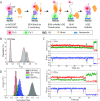Quantifying the impact of small molecule ligands on G-quadruplex stability against Bloom helicase
- PMID: 31544934
- PMCID: PMC6847008
- DOI: 10.1093/nar/gkz803
Quantifying the impact of small molecule ligands on G-quadruplex stability against Bloom helicase
Abstract
G-quadruplex (GQ) stabilizing small molecule (SM) ligands have been used to stabilize human telomeric GQ (hGQ) to inhibit telomerase activity, or non-telomeric GQs to manipulate gene expression at transcription or translation level. GQs are known to inhibit DNA replication unless destabilized by helicases, such as Bloom helicase (BLM). Even though the impact of SM ligands on thermal stability of GQs is commonly used to characterize their efficacy, how these ligands influence helicase-mediated GQ unfolding is not well understood. Three prominent SM ligands (an oxazole telomestatin derivative, pyridostatin, and PhenDC3), which thermally stabilize hGQ at different levels, were utilized in this study. How these ligands influence BLM-mediated hGQ unfolding was investigated using two independent single-molecule approaches. While the frequency of dynamic hGQ unfolding events was used as the metric in the first approach, the second approach was based on quantifying the cumulative unfolding activity as a function of time. All three SM ligands inhibited BLM activity at similar levels, 2-3 fold, in both approaches. Our observations suggest that the impact of SM ligands on GQ thermal stability is not an ideal predictor for their inhibition of helicase-mediated unfolding, which is physiologically more relevant.
© The Author(s) 2019. Published by Oxford University Press on behalf of Nucleic Acids Research.
Figures


References
-
- Merle P., Gueugneau M., Teulade-Fichou M.P., Muller-Barthelemy M., Amiard S., Chautard E., Guetta C., Dedieu V., Communal Y., Mergny J.L. et al. .. Highly efficient radiosensitization of human glioblastoma and lung cancer cells by a G-quadruplex DNA binding compound. Sci. Rep. 2015; 5:16255. - PMC - PubMed
Publication types
MeSH terms
Substances
Grants and funding
LinkOut - more resources
Full Text Sources
Other Literature Sources

